地磁风暴引起的高能粒子降水在改变美洲和非洲纵向扇区电离层中的作用
IF 1.9
4区 地球科学
Q3 GEOCHEMISTRY & GEOPHYSICS
Journal of Atmospheric and Solar-Terrestrial Physics
Pub Date : 2025-05-14
DOI:10.1016/j.jastp.2025.106539
引用次数: 0
摘要
地磁风暴与辐射带中电子和质子通量的变化有关,导致降水。然而,过去的大多数研究都是基于风暴的强度进行的。本文研究了8个地磁风暴在高能粒子降水(EPP)产生中的作用,以及它们随后对电离层不规则性和总电子含量(TEC)的改变。我们使用了高能粒子通量、TEC、行星际磁场和太阳风数据。利用TEC指数速率(ROTI)作为电离层不规则性的代表。在本研究中,风暴诱发epp的能力在风暴的恢复阶段是主要和重要的。因此,电离层的变化主要是在风暴的恢复阶段引起的。在恢复阶段,由强鞘层(SH)和涡旋相互作用区(CIR)驱动的风暴引起的epp增强导致TEC和电离层不规则性相应增强,而强磁云(MC)驱动的风暴对TEC和不规则性没有显著影响。此外,强、中度MC + sh驱动的风暴引起的EPP增强对TEC和电离层不规则性的影响很小或没有变化。此外,由中等鞘层和mc驱动的风暴引起的EPP增强导致TEC耗竭和不规则性。不正常现象在低纬度和高纬度地区更为普遍,但在非洲地区中纬度地区发生的情况较少。总的来说,从这项研究来看,非洲部门对高能粒子的反应比美国部门更强烈。无论风暴发生的阶段、大小、驱动因素或当地时间如何,高纬度观测站的不规则现象普遍较高且频繁。风暴引起的EPP增强在南半球比北半球更显著,分点月事件对EPP的依赖性更强。本文章由计算机程序翻译,如有差异,请以英文原文为准。
The role of geomagnetic storm-induced energetic particle precipitations in the modification of the ionosphere over the American and African longitudinal sectors
Geomagnetic storms are associated with changes in electron and proton fluxes in the radiation belts, leading to precipitation. However, most past studies have been done based on storms’ intensities. This study investigates the roles of eight geomagnetic storms, classified by their intensities using Dst threshold conditions, and interplanetary drivers, in the production of Energetic Particle Precipitation (EPP), and their subsequent modification of ionospheric irregularities and Total Electron Content (TEC). We used energetic particle fluxes, TEC, interplanetary magnetic field, and solar wind data. The rate of TEC index (ROTI) was used as a proxy for ionospheric irregularities. In this study, the ability of a storm to induce EPPs is predominant and significant during the recovery phases of storms. Consequently, the modifications of the ionosphere caused by EPPs were mostly pronounced during the recovery phase of a storm. At the recovery phases, enhanced EPPs induced by intense sheath (SH)- and Corotating Interaction Region (CIR)-driven storms caused corresponding enhancements in TEC and ionospheric irregularities, while that of intense magnetic cloud (MC)-driven storm showed no significant effect on TEC and irregularities. Furthermore, enhanced EPP induced by intense and moderate MC + SH-driven storms caused little or no change in TEC and ionospheric irregularities. In addition, an enhanced EPP induced by moderate sheath- and MC-driven storms caused depletion in TEC and irregularities. Irregularities were more prevalent at the low- and high-latitude, but less in occurrences at the mid-latitude in the African sector. Overall, from this study, the African sector responded more to the energetic particles than the American sector. Irregularities at the high-latitude stations were generally high and frequent regardless of the phase, magnitude, driver, or local times of occurrence of storms. The storm-induced EPP enhancements were more significant in the southern hemisphere than in the northern hemisphere, and the events of the equinoctial months showed more dependence on EPPs.
求助全文
通过发布文献求助,成功后即可免费获取论文全文。
去求助
来源期刊

Journal of Atmospheric and Solar-Terrestrial Physics
地学-地球化学与地球物理
CiteScore
4.10
自引率
5.30%
发文量
95
审稿时长
6 months
期刊介绍:
The Journal of Atmospheric and Solar-Terrestrial Physics (JASTP) is an international journal concerned with the inter-disciplinary science of the Earth''s atmospheric and space environment, especially the highly varied and highly variable physical phenomena that occur in this natural laboratory and the processes that couple them.
The journal covers the physical processes operating in the troposphere, stratosphere, mesosphere, thermosphere, ionosphere, magnetosphere, the Sun, interplanetary medium, and heliosphere. Phenomena occurring in other "spheres", solar influences on climate, and supporting laboratory measurements are also considered. The journal deals especially with the coupling between the different regions.
Solar flares, coronal mass ejections, and other energetic events on the Sun create interesting and important perturbations in the near-Earth space environment. The physics of such "space weather" is central to the Journal of Atmospheric and Solar-Terrestrial Physics and the journal welcomes papers that lead in the direction of a predictive understanding of the coupled system. Regarding the upper atmosphere, the subjects of aeronomy, geomagnetism and geoelectricity, auroral phenomena, radio wave propagation, and plasma instabilities, are examples within the broad field of solar-terrestrial physics which emphasise the energy exchange between the solar wind, the magnetospheric and ionospheric plasmas, and the neutral gas. In the lower atmosphere, topics covered range from mesoscale to global scale dynamics, to atmospheric electricity, lightning and its effects, and to anthropogenic changes.
 求助内容:
求助内容: 应助结果提醒方式:
应助结果提醒方式:


